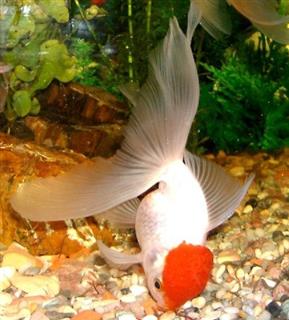Goldfish - Red Cap Oranda
Oranda, Red Scientific Name: Carassius auratus
Fri, 11th April, 2025 - 11:21 pm GMT
Sponsor Ads:

Alternative Name
Oranda, Red Scientific Name: Carassius auratusBasic Info
The beautiful Red Oranda Goldfish usually reaches about five inches in length. Many are about two inches deep. This goldfish has a large growth over its head known as a wen. Although in some fish the wen encases the whole head, except for the eyes and the mouth, in others it may be limited to the cap and cheek, the cap area, or the very highest region of the cap. Red Oranda Goldfish have long fins, including a dorsal fin. They have veiltail type tails and double caudal fins. The caudal fins are divided down about 90 percent of their length. Red Oranda Goldfish can have caudal fins that are about one and a half times the length of their bodies. The pelvic and pectoral fins are usually rounded and of medium length. They are well matched in size and appearance. Nacreous (a mix of metallic and matte) or metallic scale types are acceptable for Red Oranda Goldfish, which are solid red in color.
Health
Red Oranda Goldfish require warmer temperatures, usually around 70 to 80 degrees Fahrenheit. However, they are quite hardy and will tolerate a variety of temperatures in this immediate range. The pH level for Red Oranda Goldfish should remain between 7.0 and 8.0. Because ammonia can damage their fins, it should be kept to a minimum. Often, a filtration system that does not create too much water turbulence will be appropriate. The tanks of Red Oranda Goldfish should allow them plenty of hiding places. Cleaning should be accomplished with gradual, or partial, water change. Twice each day, Red Oranda Goldfish should be fed plant materials and protein. You should only offer as much food as the fish can eat in five minutes. Often they will eat live plants in their tanks. They can also be fed peas, spinach, lettuce, and zucchini bits. Frozen vegetable diets, plankton, bits of beef heart, bloodworms, glass worms, brine shrimp, and daphnia are also acceptable. Although more natural diets are preferred, tablet and pellet food can also be good choices. Because of the susceptibility of many fancy goldfish to digestive problems, it is suggested that Red Oranda Goldfish fed such dry food be supplemented with fresh vegetables like peas. Breeding Male Red Oranda Goldfish usually indicate a readiness to breed by developing small white tubercles over their gill coverings, pectoral fins, and heads. Because parents will often eat eggs, they should be removed from the enclosure where spawn are deposited. Usually, Red Oranda Goldfish will produce thousands of eggs.Habitat
Fresh water fishBehavior
Red Oranda Goldfish are unique in appearance and have beautifully colored scales that can provide a bright and striking compliment to many aquariums. These fish have become quite popular, due to their docile natures and interesting physical qualities. In captivity, Red Oranda Goldfish are usually quite peaceful, living nicely with other fish and exhibiting schooling behavior. They do require warmer waters, however, and thus should not be kept outside in ponds or in cooler enclosures. Oranda Goldfish are known to be quite docile. They are usually kept because of their interesting appearances, and many people prefer to feed them color or growth enhancing foods. Many Red Oranda Goldfish have been killed with overfeeding, so you should stick to a set diet to keep your fish healthy.Origin
ChinaHistory
Red Oranda Goldfish were probably first developed in China, though the Japanese have also kept such fish for centuries. Today they are valued as exhibition fish and as pets.Common Foods
N/ASponsor Ads:
Life is not so bad if you have plenty of luch, a good physique and not too much imagination. --Christopher Isherwood
Goldfish - Red Cap Oranda
Coded by: BGID® | ALL RIGHTS RESERVED Copyright © 2000-2025
Disclaimer | Privacy | Report Errors / Contact | Credits


 President of the United States of America - Real Estate mogul, Pageant owner and now one of the most controversial men in political history.
President of the United States of America - Real Estate mogul, Pageant owner and now one of the most controversial men in political history.  Politician, US Vice President and President of the USA - Joseph Robinette Biden Jr.
Politician, US Vice President and President of the USA - Joseph Robinette Biden Jr.  versus
versus  Russia: 'The Evil Empire'? Are they all that bad or is it just the USA trying to portray Russia as bad because they are a world power with land bigger and a society very different from the USA ideal?
Russia: 'The Evil Empire'? Are they all that bad or is it just the USA trying to portray Russia as bad because they are a world power with land bigger and a society very different from the USA ideal?  Global warming has been in and out as the "latest" hot topic for many years. It is, according to modern scientists, the result of man-made industrial pollutants, clearing forested areas, agriculture, etc. But now they are thinking it started way before the Industrial Revolution...
Global warming has been in and out as the "latest" hot topic for many years. It is, according to modern scientists, the result of man-made industrial pollutants, clearing forested areas, agriculture, etc. But now they are thinking it started way before the Industrial Revolution... 
 Corona virus
Corona virus 
 Users with wide screen monitors can benefit from more content on every page.
Users with wide screen monitors can benefit from more content on every page.